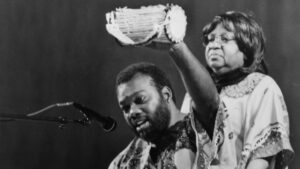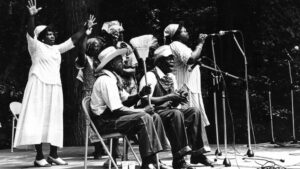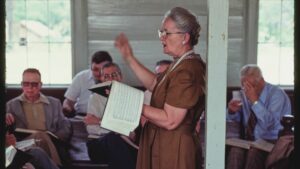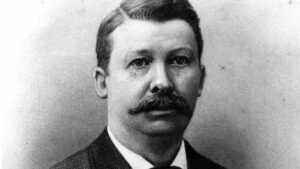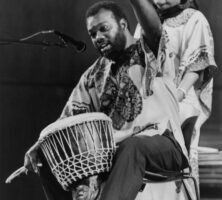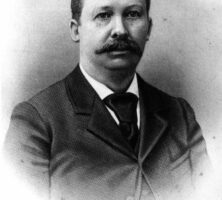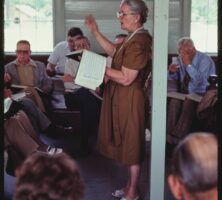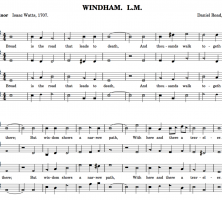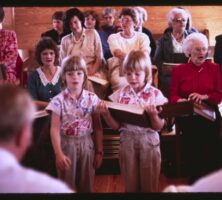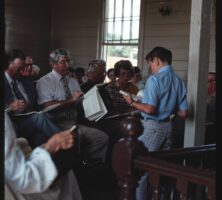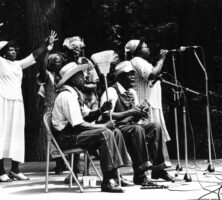The New Georgia Encyclopedia is supported by funding from A More Perfect Union, a special initiative of the National Endowment for the Humanities.
Tony Merrell drums during a performance of the Georgia Sea Island Singers, as fellow member Frankie Sullivan Quimby looks on. The singers maintain a tradition, begun around 1900, of sharing the Gullah culture through performances and educational programs.
Courtesy of Georgia Sea Island Singers
The New Georgia Encyclopedia does not hold the copyright for this media resource and can neither grant nor deny permission to republish or reproduce the image online or in print. All requests for permission to publish or reproduce the resource must be submitted to the rights holder.
The New Georgia Encyclopedia does not hold the copyright for this media resource and can neither grant nor deny permission to republish or reproduce the image online or in print. All requests for permission to publish or reproduce the resource must be submitted to the rights holder.
The New Georgia Encyclopedia does not hold the copyright for this media resource and can neither grant nor deny permission to republish or reproduce the image online or in print. All requests for permission to publish or reproduce the resource must be submitted to the rights holder.
Betty Ann Wylie explains that stories are told not only through words but also through "the paralanguage."
Video by Darby Carl Sanders, New Georgia Encyclopedia
The New Georgia Encyclopedia does not hold the copyright for this media resource and can neither grant nor deny permission to republish or reproduce the image online or in print. All requests for permission to publish or reproduce the resource must be submitted to the rights holder.
The New Georgia Encyclopedia does not hold the copyright for this media resource and can neither grant nor deny permission to republish or reproduce the image online or in print. All requests for permission to publish or reproduce the resource must be submitted to the rights holder.
The New Georgia Encyclopedia does not hold the copyright for this media resource and can neither grant nor deny permission to republish or reproduce the image online or in print. All requests for permission to publish or reproduce the resource must be submitted to the rights holder.
B. J. Abraham demonstrates how she assumes different characters by using different voices when she's telling a story.
Video by Darby Carl Sanders, New Georgia Encyclopdedia
The New Georgia Encyclopedia does not hold the copyright for this media resource and can neither grant nor deny permission to republish or reproduce the image online or in print. All requests for permission to publish or reproduce the resource must be submitted to the rights holder.
B. J. Abraham says she feels that storytelling is a "low-tech art in a high-tech world."
Video by Darby Carl Sanders, New Georgia Encyclopedia
The New Georgia Encyclopedia does not hold the copyright for this media resource and can neither grant nor deny permission to republish or reproduce the image online or in print. All requests for permission to publish or reproduce the resource must be submitted to the rights holder.
Joel Chandler Harris took his work as a fiction writer seriously, and he honed his craft considerably in the course of publishing seven volumes of short stories (in addition to the Uncle Remus tales) and three more novels.
The New Georgia Encyclopedia does not hold the copyright for this media resource and can neither grant nor deny permission to republish or reproduce the image online or in print. Requests for permission to publish or reproduce the resource should be submitted to the Hargrett Manuscript and Rare Book Library at the University of Georgia.
First published in 1844, The Sacred Harp songbook has helped to promote the style of singing known as "Sacred Harp," "shape-note," or "fasola" singing.
Courtesy of Library of Congress, Prints and Photographs Division
The New Georgia Encyclopedia does not hold the copyright for this media resource and can neither grant nor deny permission to republish or reproduce the image online or in print. All requests for permission to publish or reproduce the resource must be submitted to the rights holder.
The shape-note system in The Sacred Harp uses a different shape to represent each of the four syllables in the musical scale: a triangle (fa), a circle (sol), a rectangle (la), and a diamond (mi).
The tune "Windham" as it appears in The Sacred Harp, 1911 edition. Image from Wikimedia.
The New Georgia Encyclopedia does not hold the copyright for this media resource and can neither grant nor deny permission to republish or reproduce the image online or in print. All requests for permission to publish or reproduce the resource must be submitted to the rights holder.
Gapped scales (having less than the usual seven notes) and unusual harmonies help account for this traditional music's characteristic sound. Also unique is the doubling of two parts, both men and women singing tenor and treble. Untrained voices prevail, so the singing sounds loud and exhilarating.
Courtesy of Georgia Council for the Arts, Georgia Traditional Arts Research Collection, Abraham Baldwin Agricultural College Libraries.
The New Georgia Encyclopedia does not hold the copyright for this media resource and can neither grant nor deny permission to republish or reproduce the image online or in print. Requests for permission to publish or reproduce the resource should be submitted to the Georgia Council for the Arts.
The sound of Sacred Harp may vary a bit from region to region, and white singers have different styles from African American singers. But regardless of location or race, Sacred Harp sounds unlike academic choral singing or gospel singing, in which melody dominates and harmony embellishes and supports it.
Courtesy of Library of Congress, Prints and Photographs Division
The New Georgia Encyclopedia does not hold the copyright for this media resource and can neither grant nor deny permission to republish or reproduce the image online or in print. All requests for permission to publish or reproduce the resource must be submitted to the rights holder.
The McIntosh County Shouters, seen here performing at National Folk Festival, Wolf Trap Farm, Virginia, have helped preserve the southeastern ring shout, one of the oldest African American performance traditions in the country.
Courtesy of Margo Rosenbaum
The New Georgia Encyclopedia does not hold the copyright for this media resource and can neither grant nor deny permission to republish or reproduce the image online or in print. All requests for permission to publish or reproduce the resource must be submitted to the rights holder.
The New Georgia Encyclopedia does not hold the copyright for this media resource and can neither grant nor deny permission to republish or reproduce the image online or in print. All requests for permission to publish or reproduce the resource must be submitted to the rights holder.
The New Georgia Encyclopedia does not hold the copyright for this media resource and can neither grant nor deny permission to republish or reproduce the image online or in print. All requests for permission to publish or reproduce the resource must be submitted to the rights holder.
